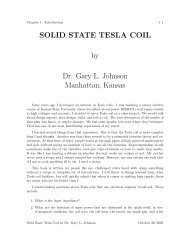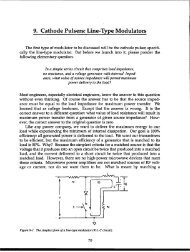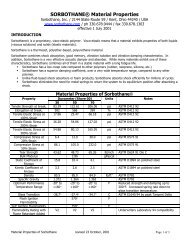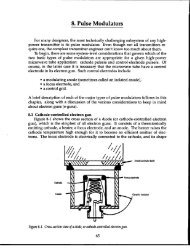3.6M north10.pdf - Dean-O's Toy Box
3.6M north10.pdf - Dean-O's Toy Box
3.6M north10.pdf - Dean-O's Toy Box
Create successful ePaper yourself
Turn your PDF publications into a flip-book with our unique Google optimized e-Paper software.
150 High-Power Microwave-Tube Transmitters<br />
+V<br />
Vidao<br />
drive<br />
----<br />
-.-t -------<br />
+ ~ Crowbar<br />
@y!-<br />
. .<br />
c<br />
J<br />
t<br />
1 &<br />
video<br />
.<br />
-v 1<br />
@ ~<br />
A. Transfomsar-casplad, @fiva-suppfy, shunt switch C. Transformer-cwplad, nagativa-supply, sarias switch<br />
(crowbar and logic must float)<br />
(vidao driie refererwad to nagafive high wilage)<br />
B. Transfonrwwxuplad, posifiva-s@y, series switti<br />
(both Iow-side pulse-transformer tannds must ba insulated<br />
for high voltage)<br />
D. Diract-couplad, rwgatke-suppty, .serfes switch<br />
(sams as above, but switch must be salad forbad<br />
wlfaga)<br />
Figure 10-3. Alternative circuit arrangements for hard-tube modulators.<br />
For a crossed-field-type device, the effect of voltage change will be far more<br />
pronounced. In this case, APz#PB will be as much as llAVO/VO,and the approximate<br />
per-unit loss in pulse energy will be 5.5AVo/Vo. (These values refer only to<br />
loss of dc beam.) Other factors listed in Fig. 9-28 relate to how RF power output<br />
will be affected.<br />
Because beam-voltage change for small values of AV/V is very nearly linear<br />
with time, the change in RF phase angle between input and output of the RF<br />
amplifier tube will be nearly linear. (This was noted in the section that discussed<br />
phase-pushing effects.) However, linear phase change is indistinguishable from<br />
pure frequency translation: the frequency coming out is offset from the one going<br />
in. The amount of frequency difference is equal to the percentage of voltage<br />
change times the pha=pushing factor expressed in degrees per percentage of<br />
voltage change. To find the differential phase change over the duration of the<br />
pulse, this product is divided by the pulse duration, or At times 3600/cycle. In<br />
the TWT example shown, the phase-pushing factor is 40°\170AV/V, the voltage<br />
droop AV is lYo, the pulse duration is 1 ms (0.001 second). The frequency offset,<br />
A~(absolute, not per-unit), will therefore be<br />
l%x40°/1%<br />
360 X 0.001s<br />
=lllCYC<br />
/ ~=111<br />
Hz.







